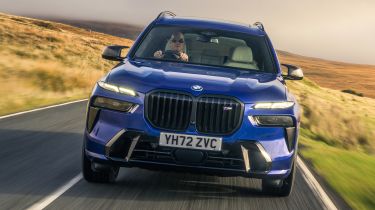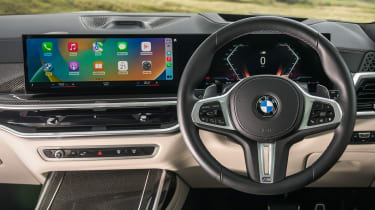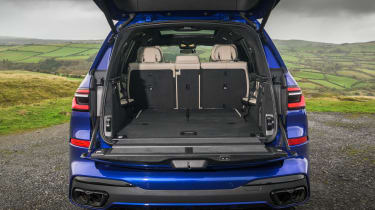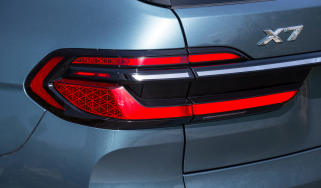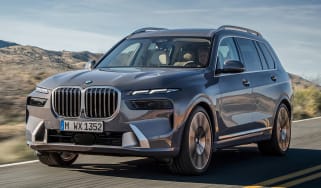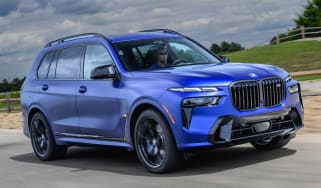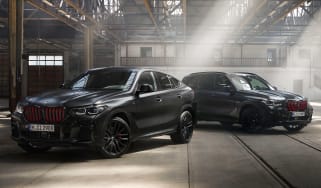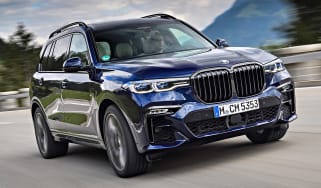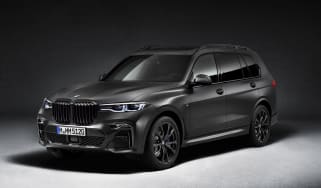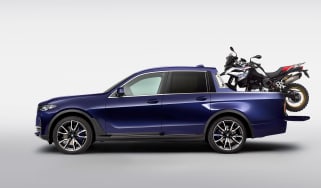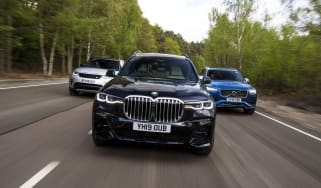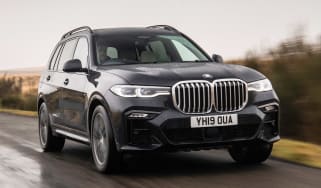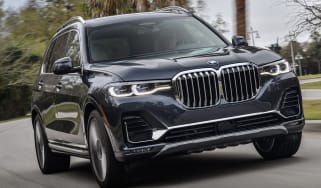BMW X7 review
As big and bold as ever, the BMW X7 surprises with a certain finesse to its driving experience matched to superb build quality and lots of kit
The X7 is BMW’s flagship full-size SUV, a high-end family car with all the luxury, technology and road presence you’d expect of something costing well over £100,000. Being a seven-seater designed primarily for markets like the US and China, it’s predictably massive yet still drives with a finesse and composure BMWs are known for.
A Volvo XC90 will be cheaper to own, and the Land Rover Discovery is a more rugged and capable family hauler, but the BMW X7’s blend of quality, luxury, high-tech equipment and superb refinement make it a compelling option – if you can get your head around its looks.
About the BMW X7
The X7 is a big seven-seater competing with a roster of rivals that includes the Land Rover Discovery, the Audi Q7 and Volvo XC90. Having undergone a comprehensive update in 2022, the X7 has been given an even more controversial design and upmarket interior, but the prices have gone up too now costing significantly more than its previous seven-seat rivals. The priciest M60i model is now priced at more than £100,000, so a foray into the options list will see the purchase price approach luxury rivals such as the Bentley Bentayga and Range Rover.
Yet while the BMW may not have all the prestige of the most luxurious brands, it makes up for it with sheer scale. In this market size really does matter, and the X7 makes for a formidable option at comfortably over 5m long, 2m wide and 1.8m tall.
Behind its imposing grille, the BMW X7 shares much of its engineering with the smaller X5, building on the same underlying CLAR platform with a longer wheelbase and boxier proportions. Just like on a Range Rover, BMW has kept the scuttle and windowline low for the sake of outward visibility, increasing that generous feeling of space inside the cabin.
Being BMW’s flagship SUV, the X7 packed with advanced technology including impressive infotainment options, driver assistance aids and safety functions. Other notable features include standard-fit adaptive air suspension, an available active anti-roll system and rear-wheel steering.
The X7’s facelift in early 2022 introduced a collection of even more controversial design elements, most notably a split-headlight arrangement designed to mimic the latest 7 Series and fully electric i7 saloon. Inside the cabin, the dashboard has also been completely redesigned to facilitate BMW’s latest curved display infotainment set-up running BMW’s latest infotainment software. There’s also been changes underneath the skin, with the previous M50i model having been replaced by the M60i, and all versions now featuring a 48-volt mild-hybrid technology to help improve fuel economy and CO2 emissions.
The X7 range is relatively limited, even if its specification is not: the X7 petrol xDrive40i and diesel xDrive40d are joined by the M60i performance model, with the entry-level cars powered by 3.0-litre straight-six engines; the petrol producing 376bhp and the oil-burner 347bhp. The M60i replaces the M50i, replacing the previous V8 with a heavily updated version designed to eventually integrate plug-in hybrid modules that we’ll see in future BMW M models. In the case of the M60i, though, it retains the same 523bhp power figure and similar torque and efficiency numbers.
All X7s come as standard with BMW’s smooth eight-speed automatic gearbox and xDrive four-wheel drive system. The standard height-adjustable air suspension can be raised to tackle rough roads or lowered for ease of access, but it’s not the sort of system designed for serious off-road use that you’ll find on a Discovery or Range Rover. Instead, the 4x4 technology works in conjunction with a range of high-end road-biased hardware that helps the X7’s on-road performance. The aids include an active anti-roll system that leverages the 48V electrics to actively reduce body roll under hard cornering, and a rear-wheel steer system that helps both high speed stability and manoeuvrability at parking speeds.
As of the 2022 update, BMW has also further simplified the available trims on the X7, with the base Excellence level bundling a serious amount of kit into a more luxurious package full of chrome brightwork, big wheels and light luxurious interior finishes.
For those wanting a sportier look, the X7’s M Sport guise adds different 21-inch wheels and a range of exterior and interior styling changes – along with more powerful brakes and BMW’s M Sport steering wheel. The step up to the M60i model adds 22-inch wheels, with massive 23-inch options available across all models for maximum bling factor.
Engines, performance and drive
BMW has a reputation for making some of the best-driving cars in their respective classes and, remarkably, this extends to include its largest, heaviest model. The X7 is not a sports car by any means, but is a two tonne-plus SUV that manages to not embarrass itself when the roads get twisty.
It’s certainly not engaging, but never feels uncomfortably vague or out of its depth – which is something that can’t be said of all the big SUVs in its class. Diesel and V8 engine variants make decent work of the X7’s mass, but the 40i straight-six petrol does need to be revved despite its turbocharger and hybrid-assisted torque-curve.
By and large, the X7 rides well – its air springs are set up quite softly for a modern SUV and help portray a smooth ride over all varieties of rough British tarmac. On cars with larger 22- and 23-inch wheels, smaller bumps and vibrations can find their way into the cabin, though, so it lacks the true magic carpet ride quality of a comparable Range Rover.
Overall the X7 is surprisingly good from a driver’s point of view. The usual BMW traits of well-weighted steering, large reserves of grip, smooth automatic gearboxes and responsive engines means the big SUV is easily better to drive than a Land Rover Discovery.
0-62mph acceleration and top speed
The X7’s three available engines are all very impressive, each representing high watermarks in their respective classes. The 40i straight-six petrol is a ‘nearly’ all-new engine from BMW, not only integrating the 48V mild-hybrid system and its electric ISG (Integrated Starter Generator) motor, but also a brand new cylinder head and revised combustion chambers.
This has allowed BMW to switch over to a more efficient Miller combustion cycle, streamlining the engine’s efficiency while increasing power and torque at the same time. The changes liberate an extra 46bhp compared to the previous 40i, with BMW rating its new engine at 381bhp, backed up with 540Nm of torque available from just 1,850rpm. Performance times are more than adequate for a luxury family car of this size, reaching 62mph in 5.8 seconds.
While this extra performance helps the 40i make less work of its 2,490kg kerb weight, the 40d diesel is still the preferred choice, compromising only slightly on power with 347bhp, but countering on torque which is a much more impressive 740Nm from just 1,750rpm. Its 0-62mph time is only 0.1 of a second down at 5.9 seconds, but thanks to the extra torque the performance is much more accessible and makes the car’s slightly heavier 2,545kg kerb weight seem even less of a burden.
The flagship M60i features a 523bhp twin-turbocharged V8 that you’ll also find under the bonnets of the latest Range Rover and Range Rover Sport. In this application, its performance is potentially a bit of overkill with a 0-62mph time of 4.7 seconds, but to many potential buyers the extra opulence emanating from a burbling V8 ahead of you is just as important as its improved on-paper performance figures.
In all three cases, the ISG motor is mounted within the gearbox housing and acts as both a starter motor and generator. Regenerative brakes capture kinetic energy in a small lithium ion battery, enabling that small ISG to assist the engine at low revs and under hard acceleration. The effect is subtle, but does successfully streamline the engine’s operations and makes all the powertrains very smooth thanks to some deft calibration between engine, electric motor and eight-speed gearbox.
MPG, CO2 and running costs
The BMW X7 is not a car that’s likely to be bought with running costs in mind, although this hasn’t reduced pressure on BMW to work on reducing its fuel consumption and emissions. Entry-level 40i and 40d models will set you back nearly £87,000, with the top-flight M60i starting from just over £110,000. Choosing a few of the pricey option packs will see these figures jump further.
The most efficient model in the range is, predictably, the xDrive40d. It manages up to 36.2mpg on the combined cycle and emits from 202g/km of CO2 – not terrible for a car of this size and weight.
Petrol power brings higher fuel consumption and emissions: xDrive40i models return up to 27.7mpg and 232g/km of CO2, while the V8-powered M60i is claimed to be a little more efficient that M50i model it replaces; 23.7mpg versus 22.6mpg, and 278g/km of CO2 instead of 284g/km.
Company car users will have to brace themselves for big bills – all models sit in the uppermost 37 per cent Benefit in Kind percentage charge bracket. Private owners will be liable to pay large first-year VED payments (usually rolled into the on-the-road prices), plus a £355 surcharge on top of the £165 base-rate per year. This will bring road tax bills in years two to six of ownership to £520 per year.
Notable by its absence in the range is a plug-in hybrid variant of the X7 – rivals including the XC90 and Range Rover offer this option and can be driven on electric power alone over shorter distances. If you plan to spend most of your time in town, it’s worth considering these alternatives.
Insurance groups
The high-cost theme continues when it comes to insurance, with all models occupying insurance group 50 – the highest possible. By contrast, the XC90 spans groups 38 to 45 and the Land Rover Discovery groups 33 to 42. Look at the X7’s high-end rivals such as a full-size Range Rover or Bentley Bentayga, and they also sit in the top insurance group.
Depreciation
Our experts predict that the X7 will retain a decent chunk of its value after three years and 36,000 miles, but the fact remains that those buying brand new will stand to lose around £40,000 to depreciation over that period.
Depending on spec, the X7 should hold on to around 48-55 per cent of its original value come trade-in time – with xDrive40i M Sport versions expected to fare best. Models specified with the expensive Ultimate Pack will, on average, fare slightly worse over the three year period – holding onto around 48 per cent of their original list price.
To get an accurate valuation on a specific model check out our free car valuation tool...
Interior, design and technology
Any notion that BMW’s controversial design language might be a little more subdued when applied to its biggest SUV is thrown right out of the window when you see the X7. This is an imposing vehicle, and one that revels its excess when compared to comparatively sleek, rivals like the new Range Rover. The design, like the rest of the X7, definitely adheres to the idea that more is indeed more.
The X7’s face received the only major exterior styling change that came as part of its 2022 update, splitting its headlights into two units as seen on the new 7 Series and fully electric i7. These flank large kidney grilles and a cleaner lower section that all together create a greater distinction between this and the smaller BMW X SUV models. The rest of the design is largely unchanged, however.
The headlights themselves are BMW’s latest Matrix LED units that notably do without the laser elements on the previous model. Instead, the new generation LED lights are said to be just as powerful, and leave space for the active elements to be more flexible in their light spread. The small units above house the daytime running lights and indicators, which now gently pulse rather than blink sharply.
The X7’s interior has also undergone a substantial update, with a totally new dashboard and user interface, bringing it in-line with BMW’s latest generation models. Like the exterior, the design is rather complex and certainly not understated, but quality is extremely impressive both in build and materials. Most models are fitted with BMW’s high-end Marino leather finish, but an animal-free leatherette is available as an option.
For the ultimate luxury experience, BMW’s Ultimate Pack bundles things like crystal-finished interior controls, a massive three-piece sunroof and brilliant Bowers and Wilkins sound system, but at £12,500 is an expensive indulgence for what is already a very well specified luxury car.
Sat-nav, stereo and infotainment
The main driver for BMW to replace the X7’s dashboard wholesale is the application of its ‘Curved Display’ infotainment. This sleek free-standing display houses both a 12.3-inch digital instrument panel and a 14.9-inch touchscreen central infotainment unit operating the manufacturer's latest iDrive 8 system.
The feature-packed set-up includes Apple CarPlay and Android Auto connectivity, while opting for the Entertainment Pack brings a rear touchscreen, a DVD player and a TV tuner.
In terms of the user interface, it’s perhaps not as intuitive to use as previous iDrive systems, but is fast, responsive and reliable. With so much capability within the control interface, commonly-used functions can be lost amongst a sea of rather more superfluous applications.
Practicality, comfort and boot space
The BMW X7 is a large seven-seat SUV that will happily accommodate large families or groups of executives alike – it’s very spacious inside the large cabin, which in turn only helps to increase its luxurious feel.
The standard seating layout is two-three-two, with a six-seater captain's chair second row option available. Being so tall, access to the third row is tricky on account of the height of the floor, but the actual opening is both wide and electrically actuated.
Up front, the driver benefits from BMW’s ability to create a near-perfect driving position; there’s lots of electrically actuated adjustment in the standard-fit Comfort seats and steering column. There’s also a great view out over the car’s long, squared-off bonnet, while all-round visibility is excellent thanks to the tall glasshouse. The standard parking assistance features do a good job of helping out in tighter spots, but the cameras are a must-have on something so big.
Along with the predictably massive boot, interior storage is plentiful – big door bins, a large centre cubby and plenty of cup holders, including for the passengers in the rearmost seats. The boot is still spacious with all the seats in place, and thanks to the boxy roofline is able to be stacked above the parcel shelf if need be.
Dimensions and size
The X7 is one of the larger cars on sale in the UK – it’s 5,151mm long, 1,805mm tall and exactly 2,000mm wide not including the side mirrors. Parking a car as big as this in multi-storey car parks will always be a challenge, especially given that you’d almost fit a Suzuki Jimny in its wheelbase, but this is something the rear-wheel steering does at least attempt to lessen. The Land Rover Discovery and Volvo XC90 are both a little shorter and narrower, but a modern Range Rover will have just as much trouble in most tight parking spots.
Leg room, head room & passenger space
The BMW X7 comes with seven seats as standard and unlike some rivals it offers all seven of its occupants a luxurious, spacious journey; it’s not dark or cramped in the rearmost seats.
A six-seat configuration is available for £660, replacing the central bench with two armchair-type seats. This is a good option if you don’t need the extra seat as access to the rear is improved.
Front and middle-row passengers have buckets of room in all directions, while those in the rear will find little to complain about. There are Isofix points on the outer two middle seats and two in the rear as an added bonus for large families.
Boot space
The BMW X7 has a big boot, even with all seven seats in place. With seven occupants it’ll hold 326 litres, comfortably more than you get in a Discovery or XC90. Fold down the third row and there’s 750 litres – considerably less than the Discovery’s 1,137 in the same configuration. Naturally, all rear seats fold at the touch of a button.
Fold down the middle row and there’s a van-like 2,120 litres to play with. By contrast, the Volvo XC90 has 1,816 litres. However, the X7 can’t quite match the Discovery’s cavernous 2,406 litre boot for outright space. Regardless, the BMW’s boot is well-shaped and perfect for moving furniture and suitcases alike – the loading of which is made easier by a split tailgate.
Towing
The X7 makes for a particularly opulent tow car – xDrive30d models can tow a 2,200kg braked trailer or 750kg unbraked, while the M50d improves on the braked figure with a 2,600kg rating. All models can be fitted with a tow hitch at no extra cost. The petrol-powered xDrive40i has the same ratings as the xDrive40d, while the M50i has the biggest braked rating at 2,700kg.
Those looking to tow the most weight possible are still better served by the Land Rover Discovery and its 3,500kg rating.
Reliability and safety
The X7 didn't feature in our latest Driver Power owner satisfaction survey, while BMW itself could only manage a lowly 21st position out of 29 manufacturers.
Euro NCAP is yet to test the X7 but there’s no reason to doubt the car’s safety credentials given the good performance of other modern BMW models. The X7 is loaded with up-to-date active safety and driver assistance systems including adaptive LED headlights, automatic emergency braking (AEB), cruise control, a speed limiter and a driver attentiveness monitor.
Opt for the Technology package and the X7 gets active cruise, lane-change and departure warning, lane-keep assist with active side collision protection and many more sophisticated systems. It’s easily a match for the safety-conscious Volvo XC90 in this regard.
Warranty
All BMW models are covered by a three-year, unlimited-mileage warranty as standard. This compares favourably to the three years and 60,000 miles offered by Volvo and matches that offered by Land Rover. The warranty also includes three years of roadside recovery.
Servicing
BMW offers fixed-price servicing for its models and owners can spread the costs of maintenance. Schemes include BMW Value Service, Fast Lane Service (with a 90-minute turnaround) and Service While You Fly, whereby a participating service centre near an airport can service your car while you travel.
More reviews
Which Is Best
Cheapest
- NamexDrive40i MHT Excellence 5dr Step Auto
- Gearbox typeSemi-auto
- RRP£91,090
Most Economical
- NamexDrive40d MHT M Sport 5dr Step Auto
- Gearbox typeSemi-auto
- RRP£95,220
Fastest
- NamexDrive M60i 5dr Step Auto
- Gearbox typeSemi-auto
- RRP£114,745

